Assessing Recent Changes in the Contribution of Rainfall and Air Temperature Effects to Mean Flow and Runoff in Two Slovenian–Croatian Basins Using MLR and MLLR
Abstract
1. Introduction
2. Materials and Methods
2.1. Basin Description
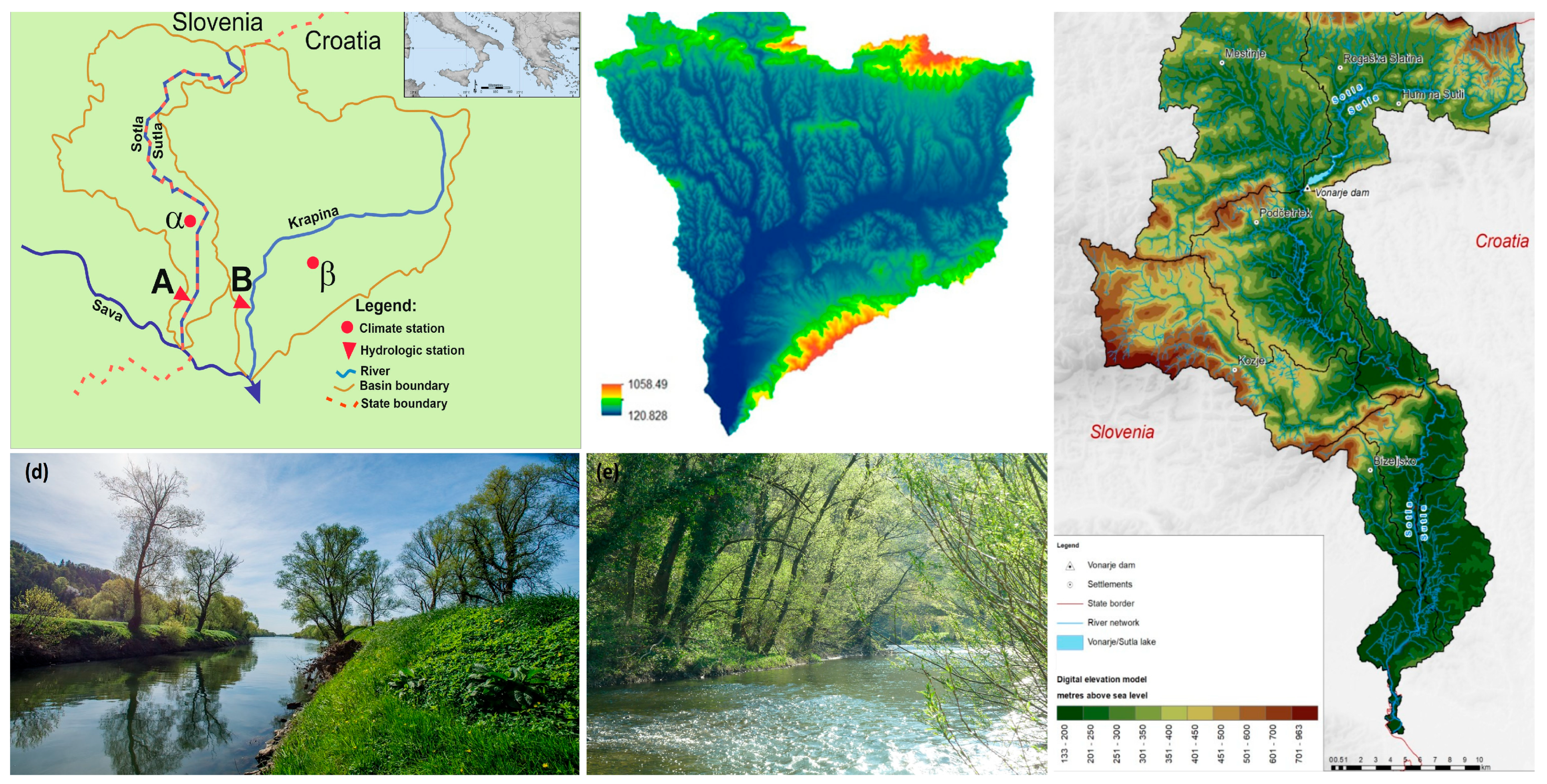
2.2. Data Used
| Station (Label) | River/Station | Coordinates | Elevation (m a.s.l.) | Record Period | Drainage Area |
|---|---|---|---|---|---|
| Rakovec (A) | Sutla River—Discharge | 45°55′48″ N, 15°37′30″ E | 140.02 | 1926–2022 (93 years) | 561.3 km2 (96.6%) |
| Kupljenovo (B) | Krapina River—Discharge | 45°56′05″ N, 15°49′03″ E | 128.88 | 1964–2023 (60 years) | 1150 km2 (93%) |
| Bizeljsko (α) | Meteorological—Slovenia | 46°00′58″ N, 15°41′46″ E | 175 | 1951–2024 (74 years) | |
| Stubičke Toplice (β) | Meteorological—Croatia | 45°58′31″ N, 15°55′26.9″ E | 180 | 1961–2024 (64 years) |
2.3. Methods
3. Results
3.1. Mean Annual Discharges
3.2. Annual Precipitation
3.3. Mean Annual Air Temperatures
3.4. Annual Runoff Coefficient
3.5. Relationship Between Mean Annual Discharges (Q), Annual Precipitation (P) and Mean Annual Air Temperatures (T)
3.6. Relationship Between Annual Runoff Coefficients, Annual Precipitations, and Mean Annual Air Temperatures
4. Discussion
5. Concluding Remarks
- Since 2000, both catchments have experienced a significant decline in mean annual discharge, coinciding with a marked increase in mean annual air temperatures beginning around 1992.
- In recent decades, air temperature has emerged as a more dominant driver than precipitation, exerting a strong negative influence on both streamflow and runoff coefficients. However, a direct comparison of the relative impacts of temperature and precipitation requires further investigation using standardized predictors.
- Runoff coefficients remain closely linked to precipitation and discharge, yet they are also shaped by local geomorphological, pedological, and land-use characteristics.
- The Krapina basin, characterized by permeable soils and gentler slopes, shows lower runoff coefficient values and higher infiltration losses.
- The Sutla basin, with steeper slopes and shorter concentration times, exhibits higher runoff coefficients and more intense surface runoff.
- Regression analyses using both MLR and MLLR approaches yielded consistent results, highlighting the increasingly nonlinear and basin-specific impacts of climate change on runoff.
- The declining sensitivity of runoff coefficients to precipitation and temperature, compared to discharge, underscores the need to incorporate additional local variables, particularly land-use, into future hydrological modeling.
Author Contributions
Funding
Data Availability Statement
Acknowledgments
Conflicts of Interest
References
- Lehner, F.; Wood, A.W.; Vano, J.A.; Lawrence, D.M.; Clark, M.P.; Mankine, J.S. The potential to reduce uncertainty in regional runoff projections from climate models. Nat. Clim. Change 2019, 9, 926–933. [Google Scholar] [CrossRef]
- Bosmans, J.; Wanders, N.; Bierkens, M.F.; Huijbregts, M.A.; Schipper, A.M.; Barbarossa, V. FutureStreams, a global dataset of future streamflow and water temperature. Sci. Data 2022, 9, 307. [Google Scholar] [CrossRef]
- Guven, A.; Pala, A.; Sheikhvaisi, M. Investigation of impact of climate change on small catchments using different climate models and statistical approaches. Water Supply 2022, 22, 3540–3552. [Google Scholar] [CrossRef]
- Barnett, T.P.; Adam, J.C.; Lettenmaier, D.P. Potential impacts of a warming climate on water availability in snow-dominated regions. Nature 2005, 438, 303–309. [Google Scholar] [CrossRef] [PubMed]
- Alcamo, J.; Flörke, M.; Märker, M. Future Long-Term Changes in Global Water Resources Driven by Socio-Economic and Climatic Changes. Hydrol. Sci. J. 2007, 52, 247–275. [Google Scholar] [CrossRef]
- Gardner, L.R. Assessing the effect of climate change on mean annual runoff. J. Hydrol. 2009, 379, 351–359. [Google Scholar] [CrossRef]
- Alkama, R.; Decharme, B.; Douville, H.; Ribes, A. Trends in global and basin-scale runoff over the late twentieth century: Methodological issues and sources of uncertainty. J. Clim. 2011, 24, 3000–3014. [Google Scholar] [CrossRef]
- Schneider, C.; Laizé, C.L.R.; Acreman, M.C.; Flörke, M. How Will Climate Change Modify River Flow Regimes in Europe? Hydrol. Earth Syst. Sci. 2013, 17, 325–339. [Google Scholar] [CrossRef]
- Sohoulande Djebou, D.C.; Singh, V.P. Impact of Climate Change on the Hydrologic Cycle and Implications for Society. Environ. Soc. Psychol. 2016, 1, 36–49. [Google Scholar] [CrossRef]
- Chaturvedi, A.; Pandey, B.; Yadav, A.K.; Saroj, S. An Overview of the Potential Impacts of Global Climate Change on Water Resources. In Water Conservation in the Era of Global Climate Change; Elsevier: Amsterdam, The Netherlands, 2021; pp. 99–120. ISBN 978-0-12-820200-5. [Google Scholar]
- Bonacci, O.; Žaknić-Čatović, A.; Roje-Bonacci, T. Comparative hydrological analysis at two stations on the boundary river Sotla/Sutla (Slovenia-Croatia). Acta Hydrotech. 2025, 38, 15–27. [Google Scholar] [CrossRef]
- Grosser, P.F.; Schmalz, B. Assessing the Impacts of Climate Change on Hydrological Processes in a German Low Mountain Range Basin: Modelling Future Water Availability, Low Flows and Water Temperatures Using SWAT+. Environments 2025, 12, 151. [Google Scholar] [CrossRef]
- Eckhardt, K.; Ulbrich, U. Potential impacts of climate change on groundwater recharge and streamflow in a central European low mountain range. J. Hydrol. 2003, 284, 244–252. [Google Scholar] [CrossRef]
- Manuel, R.-M.V.; Gunter, K.T. Parsimonious Model of Groundwater Recharge Potential as Seen Related with Two Topographic Indices and the Leaf Area Index. Hydrology 2025, 12, 127. [Google Scholar] [CrossRef]
- Milly, P.C.; Dunne, K.A. Colorado River flow dwindles as warming-driven loss of reflective snow energizes evaporation. Science 2020, 367, 1252–1255. [Google Scholar] [CrossRef]
- Yu, J.; Fu, G.; Cai, W.; Cowan, T. Impacts of precipitation and temperature changes on annual streamflow in the Murray–Darling Basin. Water Int. 2010, 35, 313–323. [Google Scholar] [CrossRef]
- Fan, M.; Xu, J.; Chen, Y.; Fan, M.; Yu, W.; Li, W. Temperature Contributes More than Precipitation to Runoff in the High Mountains of Northwest China. Remote Sens. 2022, 14, 4015. [Google Scholar] [CrossRef]
- Han, H.; Hou, J.; Huang, M.; Li, Z.; Xu, K.; Zhang, D.; Bai, G.; Wang, C. Impact of soil and water conservation measures and precipitation on streamflow in the middle and lower reaches of the Hulu River Basin, China. Catena 2020, 195, 104792. [Google Scholar] [CrossRef]
- Yeste, P.; Josa-Cánovas, J.-J.; Romero-Jiménez, E.; Ojeda, M.G.-V.; Gámiz-Fortis, S.R.; Castro-Díez, Y.; Esteban-Parra, M.J. Projected hydrologic changes over the north of the Iberian Peninsula using a Euro-CORDEX multi-model ensemble. Sci. Total Environ. 2021, 777, 146126. [Google Scholar] [CrossRef]
- Tsegaw, A.T.; Pontoppidan, M.; Kristvik, E.; Alfredsen, K.; Muthanna, T.M. Hydrological impacts of climate change on small ungauged catchments—Results from a global climate model–regional climate model–hydrologic model chain. Nat. Hazards Earth Clim. Sci. 2020, 20, 2133–2155. [Google Scholar] [CrossRef]
- Alvarenga, L.A.; de Mello, C.R.; Colombo, A.; Chou, S.C.; Cuartas, L.A.; Viola, M.R. Impacts of Climate Change on the Hydrology of a Small Brazilian Headwater Catchment Using the Distributed Hydrology-SoilVegetation Model. Am. J. Clim. Change 2018, 7, 355–366. [Google Scholar] [CrossRef]
- Visessri, S.; McIntyre, N. Regionalisation of hydrological responses under land-use change and variable data quality. Hydrol. Sci. J. 2016, 61, 302–320. [Google Scholar] [CrossRef]
- Paredes, J.M.; Romero, F.E.O.; Ocampo, S.M. Interplay of climate change and human activities on the hydrological dynamics and environmental degradation of the Senguerr River Basin, Argentina. J. S. Am. Earth Sci. 2025, 162, 105608. [Google Scholar] [CrossRef]
- Blaskey, D.; Cheng, Y.; Newman, A.J.; Koch, J.C.; Gooseff, M.N.; Musselman, K.N. Alaskan Hydrology in Transition: Changing Precipitation and Evapotranspiration Patterns Are Projected to Reshape Seasonal Streamflow and Water Temperature by Midcentury (2035–64). J. Hydrometeorol. 2025, 26, 613–626. [Google Scholar] [CrossRef]
- Van Vliet, M.T.; Franssen, W.H.; Yearsley, J.R.; Ludwig, F.; Haddeland, I.; Lettenmaier, D.P.; Kabat, P. Global river discharge and water temperature under climate change. Glob. Environ. Change 2013, 23, 450–464. [Google Scholar] [CrossRef]
- Michel, A.; Schaefli, B.; Wever, N.; Zekollari, H.; Lehning, M.; Huwald, H. Future water temperature of rivers in Switzerland under climate change investigated with physics-based models. Hydrol. Earth Syst. Sci. 2022, 26, 1063–1087. [Google Scholar] [CrossRef]
- McBean, E.; Bhatti, M.; Singh, A.; Mattern, L.; Murison, L.; Delaney, P. Temperature modeling, a key to assessing impact on rivers due to urbanization and climate change. Water 2022, 14, 1994. [Google Scholar] [CrossRef]
- Ficklin, D.L.; Hannah, D.M.; Wanders, N.; Dugdale, S.J.; England, J.; Klaus, J.; Kelleher, C.; Khamis, K.; Charlton, M.B. Rethinking river water temperature in a changing, human-dominated world. Nat. Water 2023, 1, 125–128. [Google Scholar] [CrossRef]
- White, J.C.; Khamis, K.; Dugdale, S.; Jackson, F.L.; Malcolm, I.A.; Krause, S.; Hannah, D.M. Drought impacts on river water temperature: A process-based understanding from temperate climates. Hydrol. Process. 2023, 37, e14958. [Google Scholar] [CrossRef]
- Zhang, Y.; Chiew, F.H.S.; Li, M.; Post, D. Predicting runoff signatures using regression and hydrological modeling approaches. Water Resour. Res. 2018, 54, 7859–7878. [Google Scholar] [CrossRef]
- Zaninović, K.; Gajić-Čapka, M. Changes in Components of the Water Balance in the Croatian Lowlands. Theor. Appl. Climatol. 2000, 65, 111–117. [Google Scholar] [CrossRef]
- Köppen, W.; Geiger, R. Handbuch der Klimatologie: Das geographische System der Klimate. In Handbook of Climatology: The Geographical System of Climates; Verlag von Gebrüder Borntraeger: Berlin, Germany, 1936; p. 44. [Google Scholar]
- Čanjevac, I.; Pavlek, K.; Orešić, D. River lengths in Croatia determined from a topographic map at a scale of 1:25,000. Hrvat. Geogr. Glas. 2022, 84, 5–30. [Google Scholar] [CrossRef]
- Žiger, Z.; Bognar, A. Geomorfološka obilježja gornjeg toka rijeke Sutle [Geomorphological characteristics of the upper course of the Sutla River]. Hrvat. Geogr. Glas. 2007, 69, 25–39. [Google Scholar] [CrossRef]
- FRISCO Project. Porečja—Sotla. 2017. Available online: https://frisco-project.eu/en/river-basins/sotla/ (accessed on 26 February 2025).
- Stojilković, B.; Brečko Grubar, V. Discharge regimes of Slovenian rivers: 1991–2020. Acta Geogr. Slov. 2024, 64, 7–31. [Google Scholar] [CrossRef]
- Čosić-Flajsig, G.; Karleuša, B.; Glavan, M. Integrated water quality management model for the rural transboundary river basin—A case study of the Sutla/Sotla River. Water 2021, 13, 2569. [Google Scholar] [CrossRef]
- Bonacci, O.; Žaknić-Čatović, A.; Roje-Bonacci, T.; Bonacci, D. Assessing the Effects of Climate Change on the Hydrology of a Small Catchment: The Krapina River near Kupljenovo. Water 2025, 17, 1403. [Google Scholar] [CrossRef]
- Orešić, D.; Filipčić, A. Promjene protočnih režima najvećih Savskih i Dravskih pritoka u Hrvatskom Zagorju i gornjoj Podravini 1961–2020. [Changes in discharge regimes of the largest Sava and Drava tributaries in Hrvatsko Zagorje and upper Podravina regions (northwestern Croatia) in 1961–2020 Period]. Podravina 2024, 23, 33–52. [Google Scholar]
- Orešić, D. Morfografski pokazatelji porječja Krapine [Morphographic indicators of the Krapina river basin]. Acta Geogr. Croat. 1995, 30, 29–38. [Google Scholar]
- Ivezić, V.; Bekić, D.; Horvat, B. Modelling of basin wide daily evapotranspiration with a partial integration of remote sensing data. Atmosphere 2018, 9, 120. [Google Scholar] [CrossRef]
- Slovenian Environment Agency. Archive of Time Series [Web Page]. Ministry of the Environment, Climate and Energy. 2025. Available online: https://meteo.arso.gov.si/met/en/climate/current/time-series-archive/ (accessed on 26 February 2025).
- Papić, M. Primijenjena statistika u MS Excelu [Applied statistics in MS Excel]; Zoro: Zagreb, Croatia, 2005; p. 259. [Google Scholar]
- Shu, C.; Ouarda, T. Improved methods for daily streamflow estimates at ungauged sites. Water Resour. Res. 2012, 48, W02523. [Google Scholar] [CrossRef]
- Garbrecht, J.; Fernandez, G.P. Visualization of trends and fluctuations in climatic records. Water Res. Bull. 1994, 30, 297–306. [Google Scholar] [CrossRef]
- Bonacci, O.; Bonacci, D.; Roje-Bonacci, T.; Vrsalović, A. Proposal of a new method for drought analysis. J. Hydrol. Hydromech. 2023, 71, 100–110. [Google Scholar] [CrossRef]
- McGhee, J.W. Introductory Statistics; West Publishing Company: St Paul, MN, USA; New York, NY, USA, 1985; p. 650. [Google Scholar]
- Şen, Z.; Altunkaynak, A. A comparative fuzzy logic approach to runoff coefficient and runoff estimation. Hydrol. Process. 2006, 20, 1993–2009. [Google Scholar] [CrossRef]
- Machado, R.E.; Cardoso, T.; Mortene, M. Determination of the Runoff Coefficient (C) in catchments based on analysis of precipitation and flow events. Int. Soil Water Conserv. Res. 2021, 10, 208–216. [Google Scholar] [CrossRef]
- Che, D.; Liang, A.; Li, X.; Ma, B. Remote Sensing Assessment of Safety Risk of Iron Tailings Pond Based on Runoff Coefficient. Sensors 2018, 18, 4373. [Google Scholar] [CrossRef]
- Lallam, F.; Megnounif, A.; Ghenim, A.N. Estimating the runoff coefficient using the analytic hierarchy process. J. Water Land Dev. 2018, 38, 67–74. [Google Scholar] [CrossRef]
- Merz, R.; Blöschl, G.; Parajka, J. Spatio-temporal variability of event runoff coefficients. J. Hydrol. 2006, 331, 591–604. [Google Scholar] [CrossRef]
- Bonacci, O.; Trninić, D.; Roje-Bonacci, T. Analysis of the water temperature regime of the Danube and its tributaries in Croatia. Hydrol. Process. 2008, 22, 1014–1021. [Google Scholar] [CrossRef]
- Bonacci, O.; Đurin, B.; Roje-Bonacci, T.; Bonacci, D. The influence of reservoirs on water temperature in the downstream part of an open watercourse: A case study at Botovo Station on the Drava River. Water 2022, 14, 3534. [Google Scholar] [CrossRef]
- Hadzima-Nyarko, M.; Rabi, A.; Šperac, M. Implementation of artificial neural networks in modeling the water-air temperature relationship of the River Drava. Water Res. Manag. 2014, 28, 1379–1394. [Google Scholar] [CrossRef]
- Rabi, A.; Hadzima-Nyarko, M.; Šperac, M. Modelling river temperature from air temperature: Case of the River Drava (Croatia). Hydrol. Sci. J. 2015, 60, 1490–1507. [Google Scholar] [CrossRef]
- Bonacci, O. Analiza trendova porasta temperature vode duž toka rijeke Drave u Hrvatskoj [Analysis of water temperature increase trends along the Drava River in Croatia]. Hrvat. Vode 2024, 32, 291–301. [Google Scholar]
- Tadić, L.; Tamás, E.A.; Mihaljević, M.; Janjić, J. Potential climate impacts of hydrological alterations and discharge variabilities of the Mura, Drava, and Danube Rivers on the Natural Resources of the MDD UNESCO Biosphere Reserve. Climate 2022, 10, 139. [Google Scholar] [CrossRef]
- Bonacci, O.; Žaknić-Ćatović, A.; Roje-Bonacci, T. Significant Rise in Sava River Water Temperature in the City of Zagreb Identified across Various Time Scales. Water 2024, 16, 2337. [Google Scholar] [CrossRef]
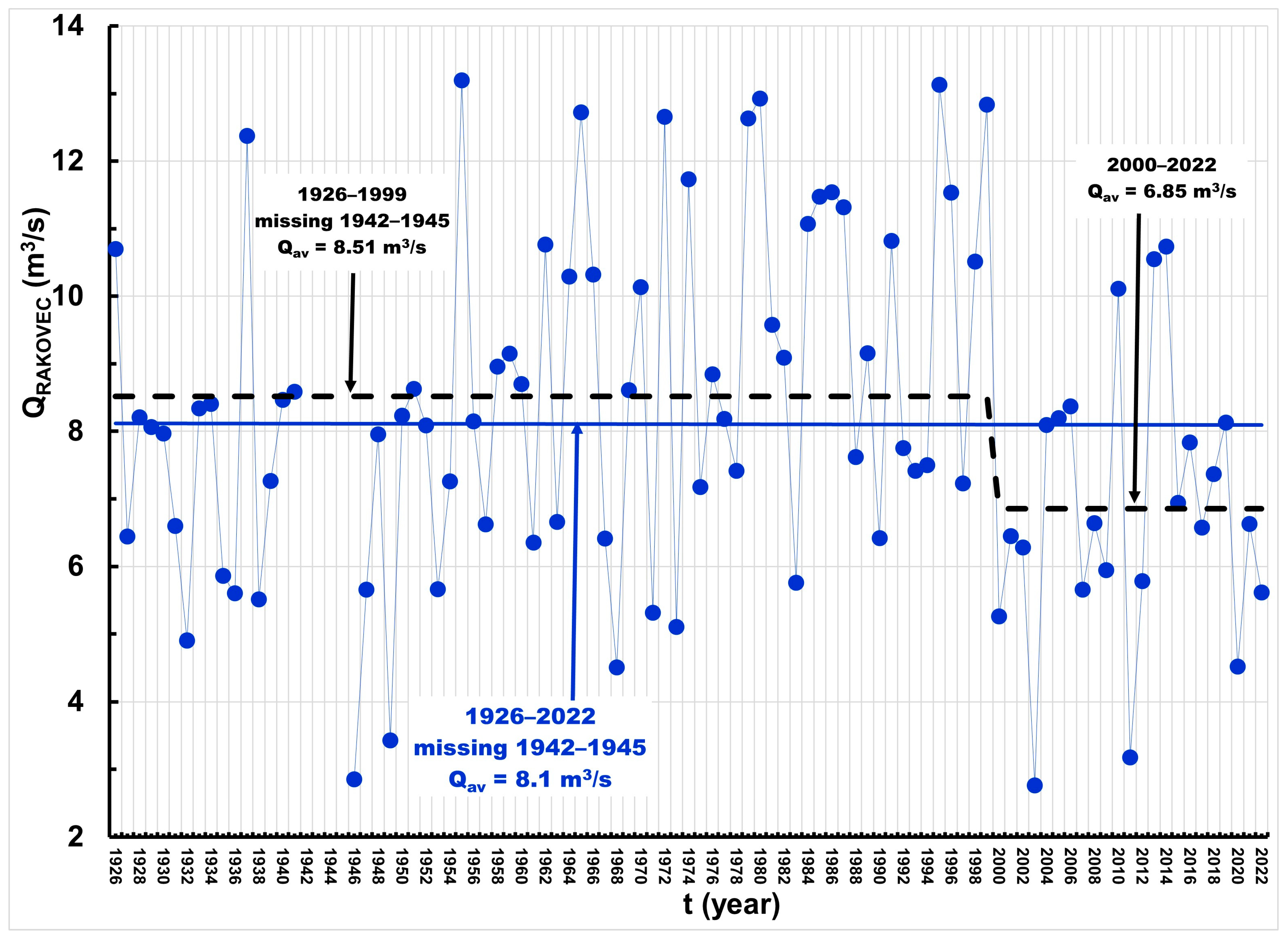


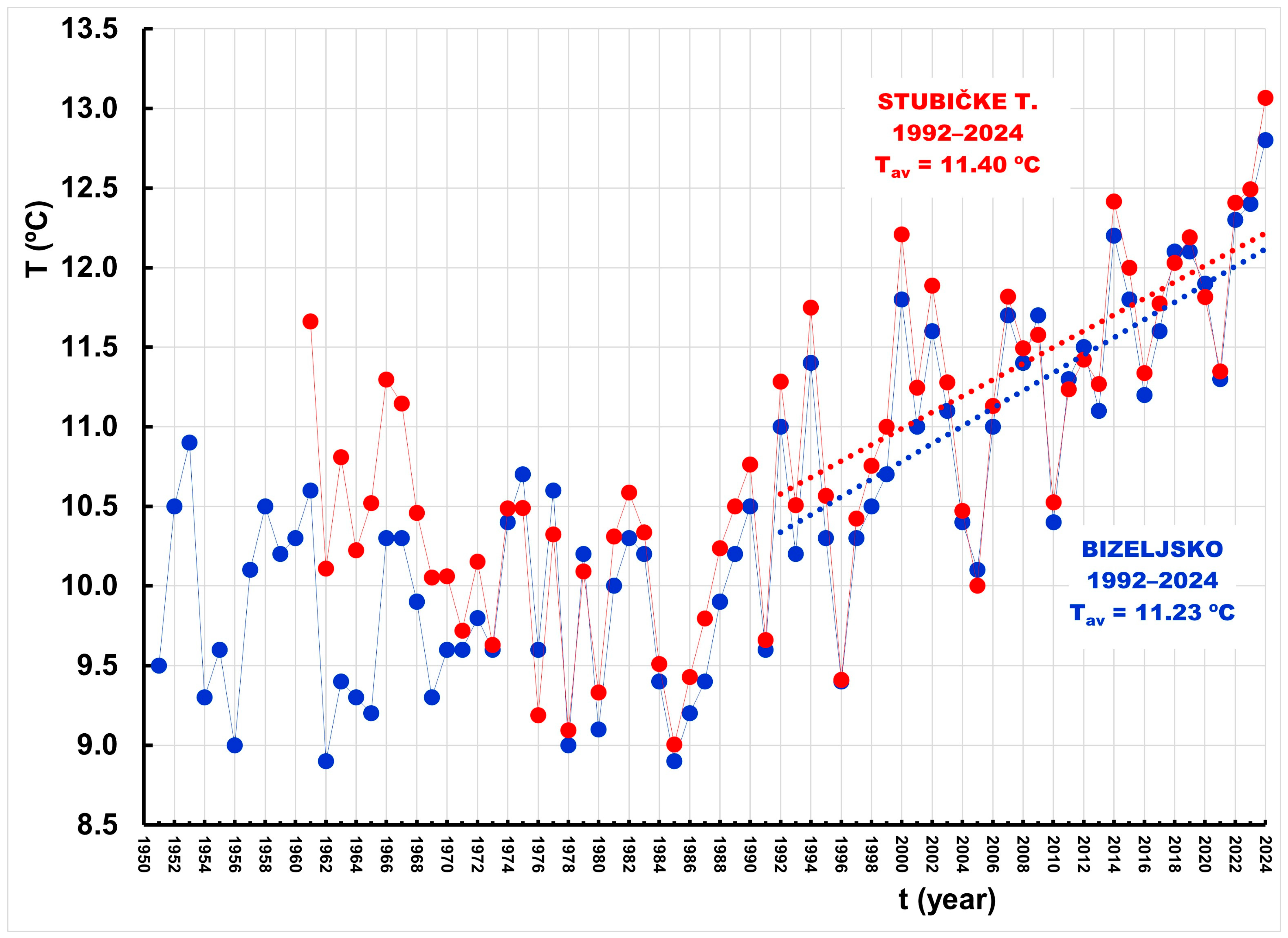
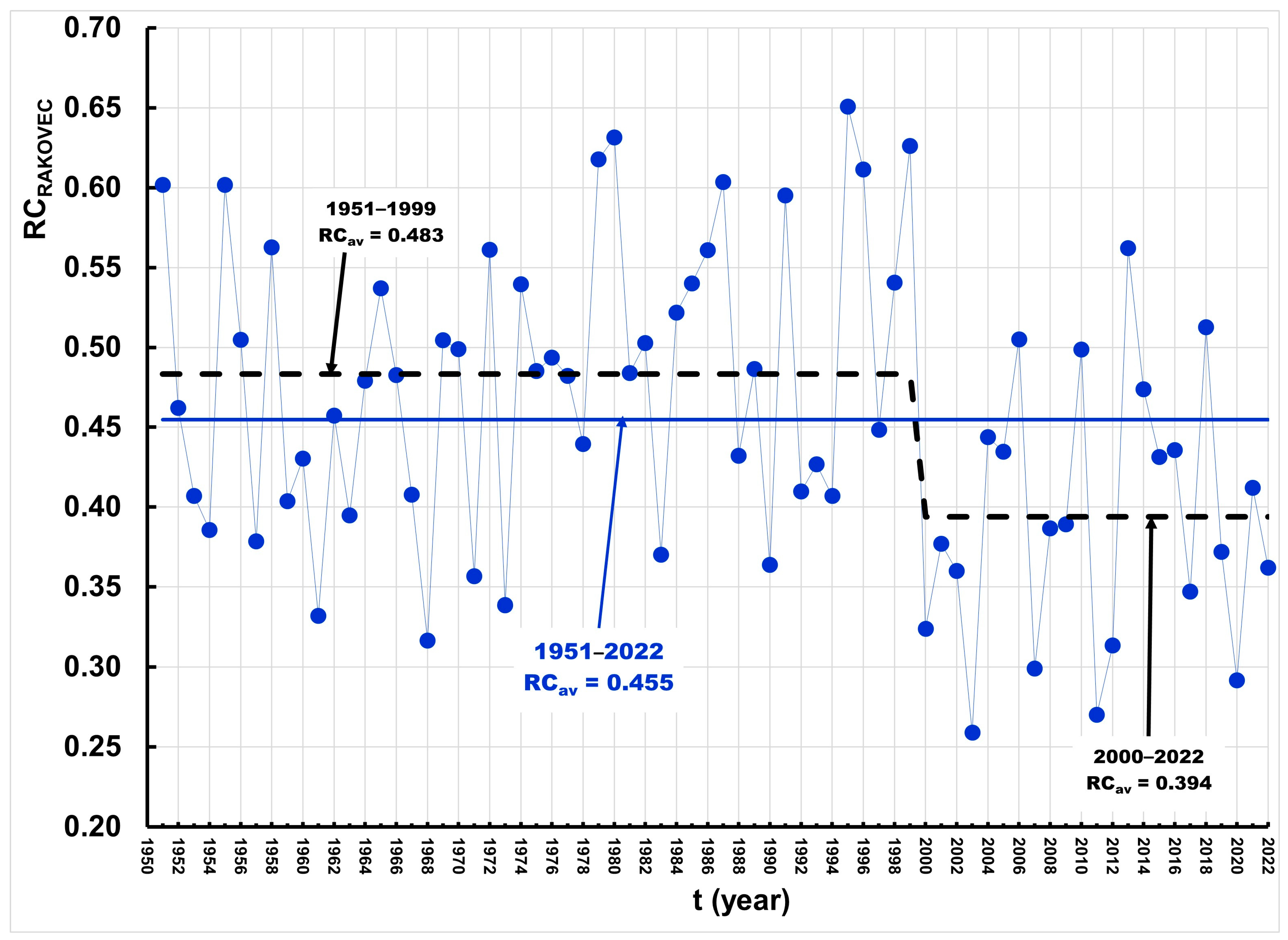
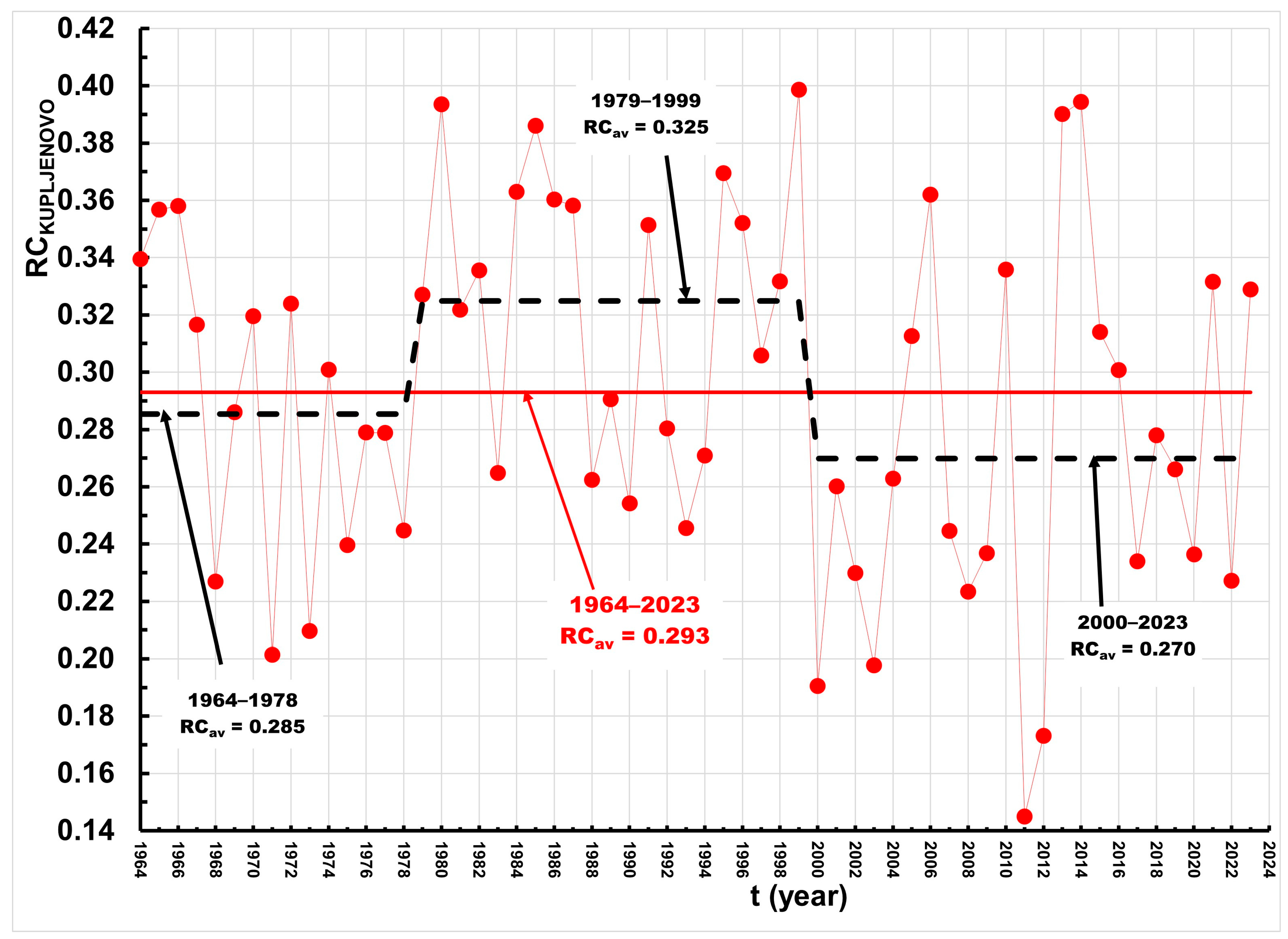

| Method | Period | Coefficient A | Coefficient B | Coefficient C | R2 |
|---|---|---|---|---|---|
| p | p | p | |||
| 1951–2022 | −0.8299 | 0.0128 | −0.374 | 0.635 | |
| 0.799 | 5.7 × 10−16 | 0.165 | |||
| MLR | 1951–1999 | −13.078 | 0.01295 | 0.8464 | 0.645 |
| 0.0076 | 2.3 × 10−11 | 0.065 | |||
| 2000–2022 | −7.090 | 0.01012 | 0.365 | 0.648 | |
| 0.626 | 2.1 × 10−5 | 0.777 | |||
| 1951–2022 | ln A = −8.2 | 1.572 | −0.572 | 0.681 | |
| 6.7 × 10−8 | 5.81 × 10−18 | 0.093 | |||
| MLLR | 1951–1999 | ln A = −10.5 | 1.558 | 0.7877 | 0.648 |
| 5.5 × 10−8 | 1.8 × 10−11 | 0.138 | |||
| 2000–2022 | ln A = −11.3 | 1.593 | −0.936 | 0.694 | |
| 0.039 | 1.9 × 10−6 | 0.658 |
| Method | Period | Coefficient A | Coefficient B | Coefficient C | R2 |
|---|---|---|---|---|---|
| p | p | p | |||
| 1964–2023 | −1.380 | 0.01831 | −0.5823 | 0.773 | |
| 0.651 | 1.34 × 10−19 | 0.022 | |||
| MLR | 1964–1999 | −3.133 | 0.01785 | −0.35748 | 0.744 |
| 0.517 | 2.7 × 10−10 | 0.421 | |||
| 2000–2023 | −1.374 | 0.01865 | −0.62041 | 0.778 | |
| 0.853 | 2.6 × 10−8 | 0.338 | |||
| 1964–2023 | ln A = −8.78 | 1.831 | −0.647 | 0.787 | |
| 8.9 × 10−11 | 2.65 × 10−20 | 0.014 | |||
| MLLR | 1964–1999 | ln A = −8.7 | 1.697 | −0.294 | 0.725 |
| 3.4 × 10−6 | 9.0 × 10−11 | 0.486 | |||
| 2000–2023 | ln A = −9.1 | 1.923 | −0.770 | 0.816 | |
| 0.00025 | 3.6 × 10−9 | 0.285 |
| Method | Period | Coefficient A | Coefficient B | Coefficient C | R2 |
|---|---|---|---|---|---|
| p | p | p | |||
| 1951–2022 | 0.4011 | 0.000282 | −0.0224 | 0.248 | |
| 0.027 | 7.11 × 10−5 | 0.129 | |||
| MLR | 1951–1999 | −0.198 | 0.000245 | 0.04185 | 0.222 |
| 0.442 | 0.0038 | 0.093 | |||
| 2000–2022 | −0.181 | 0.000217 | −0.0322 | 0.185 | |
| 0.831 | 0.056 | 0.669 | |||
| 1951–2022 | lnA = −4.2 | 0.5719 | −0.5724 | 0.290 | |
| 0.0029 | 1.13 × 10−5 | 0.094 | |||
| MLLR | 1951–1999 | ln A = −6.4 | 0.558 | 0.788 | 0.228 |
| 0.00024 | 0.0027 | 0.138 | |||
| 2000–2022 | ln A = −7.3 | 0.593 | 0.937 | 0.249 | |
| 0.171 | 0.0228 | 0.657 |
| Method | Period | Coefficient A | Coefficient B | Coefficient C | R2 |
|---|---|---|---|---|---|
| p | p | p | |||
| 1964–2023 | 0.2665 | 0.000211 | −0.01774 | 0.421 | |
| 0.0021 | 3.2 × 10−7 | 0.011 | |||
| MLR | 1964–1999 | 0.2335 | 0.000172 | −0.01027 | 0.273 |
| 0.083 | 0.00153 | 0.398 | |||
| 2000–2023 | 0.2394 | 0.000249 | −0.01899 | 0.477 | |
| 0.231 | 0.00029 | 0.269 | |||
| 1964–2023 | ln A = 5.4 | 0.8201 | −0.6557 | 0.468 | |
| 7.6 × 10−6 | 2.8 × 108 | 0.012 | |||
| MLLR | 1964–1999 | ln A = −5.21 | 0.6706 | −0.2732 | 0.308 |
| 0.0015 | 0.00058 | 0.504 | |||
| 2000–2023 | ln A = −5.8 | 0.9220 | −0.7720 | 0.511 | |
| 0.0106 | 0.00014 | 0.283 |
Disclaimer/Publisher’s Note: The statements, opinions and data contained in all publications are solely those of the individual author(s) and contributor(s) and not of MDPI and/or the editor(s). MDPI and/or the editor(s) disclaim responsibility for any injury to people or property resulting from any ideas, methods, instructions or products referred to in the content. |
© 2025 by the authors. Licensee MDPI, Basel, Switzerland. This article is an open access article distributed under the terms and conditions of the Creative Commons Attribution (CC BY) license (https://creativecommons.org/licenses/by/4.0/).
Share and Cite
Bonacci, O.; Žaknić-Ćatović, A.; Roje-Bonacci, T. Assessing Recent Changes in the Contribution of Rainfall and Air Temperature Effects to Mean Flow and Runoff in Two Slovenian–Croatian Basins Using MLR and MLLR. Water 2025, 17, 2787. https://doi.org/10.3390/w17182787
Bonacci O, Žaknić-Ćatović A, Roje-Bonacci T. Assessing Recent Changes in the Contribution of Rainfall and Air Temperature Effects to Mean Flow and Runoff in Two Slovenian–Croatian Basins Using MLR and MLLR. Water. 2025; 17(18):2787. https://doi.org/10.3390/w17182787
Chicago/Turabian StyleBonacci, Ognjen, Ana Žaknić-Ćatović, and Tanja Roje-Bonacci. 2025. "Assessing Recent Changes in the Contribution of Rainfall and Air Temperature Effects to Mean Flow and Runoff in Two Slovenian–Croatian Basins Using MLR and MLLR" Water 17, no. 18: 2787. https://doi.org/10.3390/w17182787
APA StyleBonacci, O., Žaknić-Ćatović, A., & Roje-Bonacci, T. (2025). Assessing Recent Changes in the Contribution of Rainfall and Air Temperature Effects to Mean Flow and Runoff in Two Slovenian–Croatian Basins Using MLR and MLLR. Water, 17(18), 2787. https://doi.org/10.3390/w17182787








